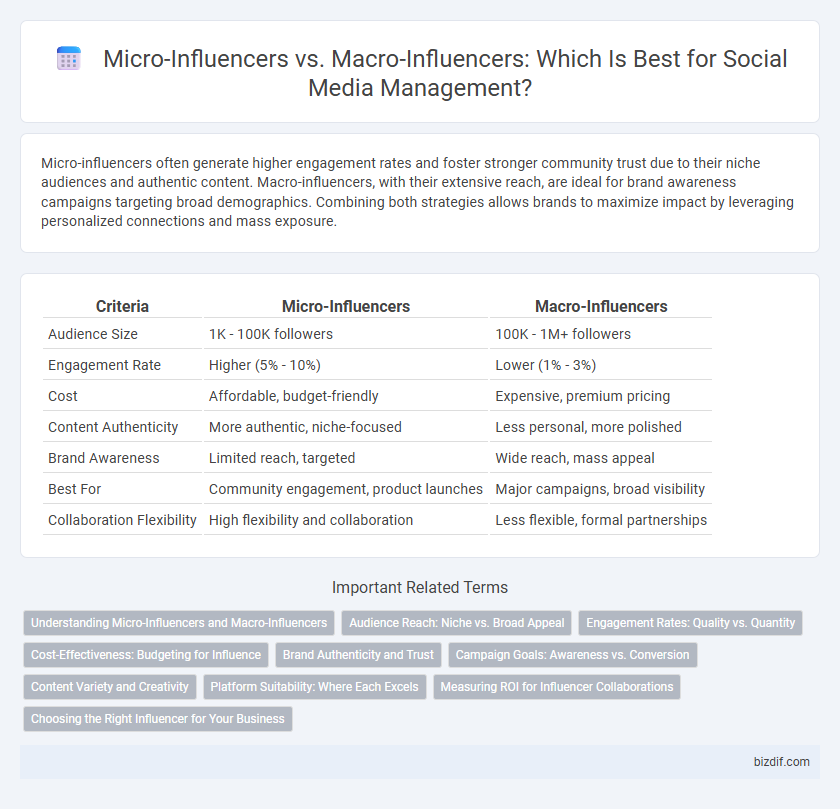Micro-influencers often generate higher engagement rates and foster stronger community trust due to their niche audiences and authentic content. Macro-influencers, with their extensive reach, are ideal for brand awareness campaigns targeting broad demographics. Combining both strategies allows brands to maximize impact by leveraging personalized connections and mass exposure.
Table of Comparison
| Criteria | Micro-Influencers | Macro-Influencers |
|---|---|---|
| Audience Size | 1K - 100K followers | 100K - 1M+ followers |
| Engagement Rate | Higher (5% - 10%) | Lower (1% - 3%) |
| Cost | Affordable, budget-friendly | Expensive, premium pricing |
| Content Authenticity | More authentic, niche-focused | Less personal, more polished |
| Brand Awareness | Limited reach, targeted | Wide reach, mass appeal |
| Best For | Community engagement, product launches | Major campaigns, broad visibility |
| Collaboration Flexibility | High flexibility and collaboration | Less flexible, formal partnerships |
Understanding Micro-Influencers and Macro-Influencers
Micro-influencers typically have 1,000 to 100,000 followers and engage niche audiences with higher interaction rates, making them ideal for targeted, authentic social media campaigns. Macro-influencers, with follower counts ranging from 100,000 to millions, offer extensive reach and brand visibility but often experience lower engagement per follower compared to micro-influencers. Understanding these distinctions helps brands optimize influencer marketing strategies by balancing reach and engagement according to campaign goals.
Audience Reach: Niche vs. Broad Appeal
Micro-influencers typically engage highly niche audiences with targeted interests, driving authentic interactions and higher engagement rates. Macro-influencers offer broad appeal with extensive reach, ideal for brand awareness on a larger scale but often with lower engagement per follower. Choosing between micro and macro-influencers depends on campaign goals, whether prioritizing deep connection or widespread visibility.
Engagement Rates: Quality vs. Quantity
Micro-influencers consistently show higher engagement rates, averaging 3-5%, compared to macro-influencers' 1-2%, indicating more meaningful audience interaction. These smaller influencers often cultivate niche, loyal communities that value authentic content, driving better quality engagement. In contrast, macro-influencers rely on larger follower bases, generating volume but often sacrificing personalized connection and engagement depth.
Cost-Effectiveness: Budgeting for Influence
Micro-influencers typically offer higher cost-effectiveness due to their lower fees and more engaged niche audiences, providing brands with better ROI on smaller budgets. Macro-influencers demand significantly higher investment but deliver broad reach and brand visibility, which may suit large-scale campaigns with substantial budgets. Allocating marketing funds involves weighing the micro-influencers' targeted engagement against the macro-influencers' extensive follower base to optimize influence per cost unit.
Brand Authenticity and Trust
Micro-influencers generate higher brand authenticity and trust due to their niche audiences and relatable content, fostering genuine engagement. Macro-influencers offer broader reach but often lack the personalized connection that builds trust with followers. Brands seeking authentic consumer relationships prioritize micro-influencers to enhance credibility and long-term loyalty.
Campaign Goals: Awareness vs. Conversion
Micro-influencers excel in driving authentic engagement and higher conversion rates due to their niche, loyal follower base, making them ideal for campaigns focused on direct sales or lead generation. Macro-influencers offer broader reach and enhanced brand awareness, effectively amplifying campaign visibility across diverse demographics but often with lower engagement rates. Selecting between micro and macro-influencers depends on whether the campaign goal prioritizes targeted conversions or widespread brand exposure.
Content Variety and Creativity
Micro-influencers often offer more content variety and creativity due to their closer connection with niche audiences, allowing for personalized and authentic posts that resonate deeply. Macro-influencers typically produce highly polished and consistent content aimed at wider audiences, leveraging professional resources but sometimes lacking the unique, spontaneous creativity seen in micro-influencer campaigns. Brands seeking innovative and diverse content should consider micro-influencers for fresh ideas and authentic engagement.
Platform Suitability: Where Each Excels
Micro-influencers excel on platforms like Instagram and TikTok where niche engagement and authentic content drive higher interaction rates. Macro-influencers thrive on broader platforms such as YouTube and Twitter, utilizing their extensive reach to generate mass awareness and viral potential. Brands seeking targeted community connection benefit more from micro-influencers, while those aiming for widespread visibility often prefer macro-influencers for their expansive audiences.
Measuring ROI for Influencer Collaborations
Micro-influencers typically deliver higher engagement rates and more targeted audiences, making ROI measurement easier through specific metrics like click-through rates and conversion tracking. Macro-influencers offer broader reach and brand awareness but require more complex ROI attribution models due to their diverse, less targeted audiences. Leveraging tracking tools such as affiliate links and unique promo codes enhances accurate ROI analysis for both micro- and macro-influencer collaborations.
Choosing the Right Influencer for Your Business
Selecting the right influencer for your business depends on target audience reach and engagement rates; micro-influencers typically offer higher engagement and niche market access with 10,000 to 100,000 followers, while macro-influencers provide broader exposure with follower counts exceeding 100,000. Businesses seeking authentic connections and cost-effective campaigns benefit from micro-influencers' personalized content and loyal communities, whereas macro-influencers drive mass awareness and brand visibility on platforms like Instagram, TikTok, and YouTube. Analyzing campaign goals, budget, and audience demographics enables strategic influencer selection, optimizing social media management outcomes.
Micro-influencers vs Macro-influencers Infographic

 bizdif.com
bizdif.com